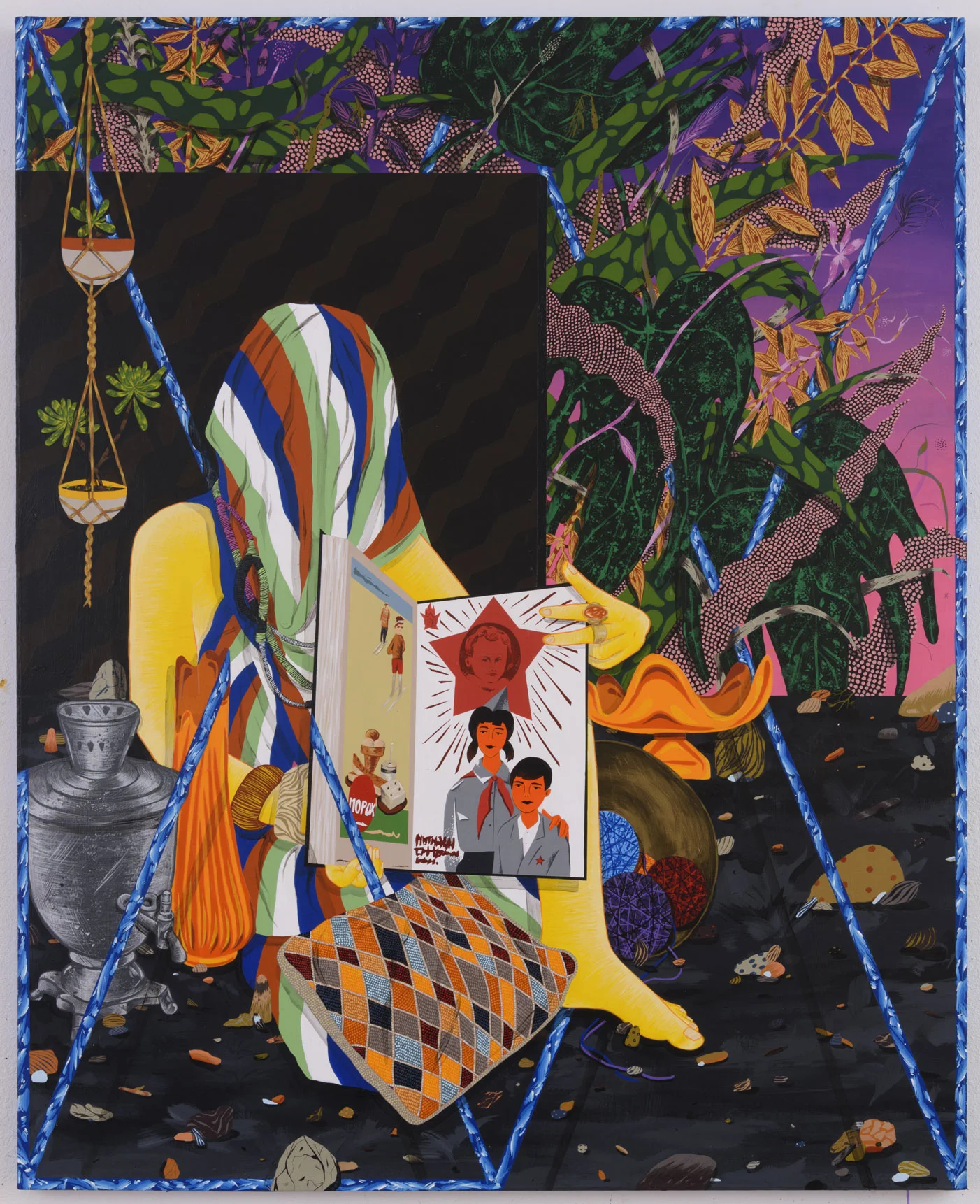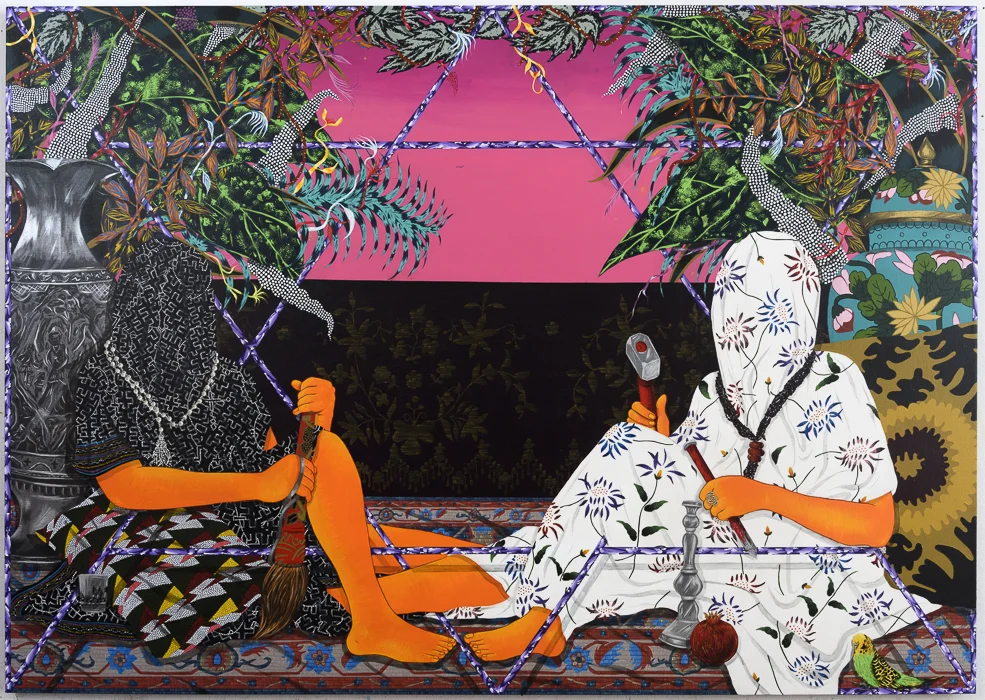Interview: A Stranger in Your Home
with Amir H. Fallah
This work appears in Khabar Keslan Issue 2. PASSAGE
Amir H. Fallah. A Stranger In Your Home, Installation view, Shulamit Nazarian, Los Angeles, September 2017. Photo: Michael Underwood. Courtesy of the artist and Shulamit Nazarian, Los Angeles.
In this interview, Amir H. Fallah discusses his research process, small possessions, and his current exhibition with Shulamit Nazarian.
Omar Alhashani: You have been a part of many projects throughout your life. In the case of Beautiful/Decay for example, which you founded when you were 16, what was it like to hand off the reigns of the project?
Amir H. Fallah: It felt like the right time to stop working on it and focus on my own projects. I wanted to have more time to devote to my own work and there simply wasn’t enough time for both. I learned a lot by publishing but, in the end, it made me realize how bad I wanted to spend all my time in the studio.
Out of curiosity, what has Beautiful/Decay been up to since the last issue? Also, where can I find a copy of Issue 1?
Beautiful/Decay is now archived. The first print issue is sold out as are many of the back issues. But I'm sure you could find one on Ebay.
Beautiful Decay, Covers of issue 1, 2, and 3. Screengrab from Beautiful Decay.
Did 'A Stranger in Your Home' start as a research tool for your portraits or did it precede the series?
I started thinking about this body of work during the 2016 presidential election in the US. There was so much talk about immigration and it made me think about what it means to be an American and how I see myself fitting into this country that I’ve spent 32 years in. Unfortunately, things got only worse for those of us who were not born here or are of a darker complexion.
The most unexpected thing that I realized during my research was that my family struggled even more than I remembered. We had a very turbulent move to America. I knew it was bad but while I interviewed my parents I found out many horrific details that were new to me.
Amir H. Fallah, Young Pioneers, 2017. Acrylic on canvas, 60 x 48 inches.
How do you find your subjects? Are you looking for something specific?
Most of the subjects were friends and relatives. I was looking for either immigrants or children of immigrants. I posted a call for models on Facebook and found the group in a few hours. From there I photographed each subject in their home and created an audio interview with them that eventually turned into a sound piece that plays in the gallery.
How about the research/interview process? What does a typical 'research ritual' look like for your paintings?
For this project, my interview process was very straightforward. I asked all my subjects the same set of questions. I wanted to capture the similarities in their feelings and stories. I wanted the audio recording to turn into a universal story of the life of immigrants, regardless of which country they came from. One surprising thing I encountered was that, regardless of the country of origin, all immigrants brought jewelry and photographs with them. These small possessions are not only easy to carry but most are charged with deep sentimental memories. I decided to create a series of botanical paintings for the show that featured some of the jewelry and photographs that people brought over with them.
Amir H. Fallah, Follow the Sun, 2017. Acrylic on canvas, 18 x 14 inches.
How has your experience with immigration (from Iran to the USA for example) engendered your craft?
Moving all over the world at an early age makes you realize how large it truly is. I experienced many cultures and got to see how wonderful exposure to diversity can be. I can’t help but think that these early experiences not only changed my worldview but also influenced my work. For instance, I sample, reference, and borrow from many movements in art history and from different cultures. I want my work to feel just as Iranian as it looks American. Within the same painting, you can have references to Persian miniatures, graphic design, graffiti, Dutch painting, and eastern ornamentation. Life is made richer when you allow yourself to experience a variety of cultures and ways of life. I think the same could be said about art.
The female figure has historically been an objectifying lens in Orientalist paintings. What does your art hope to do by representing the female figure?
Well, I honestly don’t only think about the female body. An assumption that viewers often make is that the figures in my work are all female. I paint both men and women without a distinction as to how I conceal their bodies. I’m not making any sort of commentary on Islam or veiling. Rather, I’m interested in how one can create a portrait of a person without showing their physical features. How can you reinvent the idea of what a portrait can or could be?
Amir H. Fallah, A Path Set in Stone, 2017. Acrylic on canvas, 68 x 96 inches.
Can you speak a little more about these aesthetic and social relationships we draw between fabric and femininity?
I think some often associate clothing and fashion with femininity, but I never think about clothing in those terms when it comes to my paintings. I’m looking primarily for patterns rather than clothing, and I’m not thinking about fashion. I’m not always covering the figure with actual clothes. It could be a curtain, a quilt, or a piece of raw fabric. I’m interested in the patterns on the fabric and the various symbols and embedded meanings that they contain. I also sometimes create my own pattern. I may drape a white piece of fabric over a figure and then superimpose a pattern I find elsewhere in the home. This pattern could be from wallpaper or it could be a pattern I create based on a book cover illustration.
Amir H. Fallah, Genealogy, 2017. Acrylic on canvas, 72 x 48 inches.
You've had numerous exhibitions throughout your career--California, UAE, and Iran, to name a few. Do these places feel connected?
When I first went to Dubai it seemed like the regular rules of the western art world didn’t apply. However, in only a few years, Dubai had its own biennials, fairs, museums, etc. I’m actually amazed at how fast they went from not having an art scene to being on the global art radar. I don’t think this could have been possible even twenty years ago. Technology has allowed us to access anything and everything with a click of a button. This helps places like Dubai become part of the global dialogue in less than a decade. It’s quite amazing.
Amir H. Fallah. A Stranger In Your Home, Installation view, Shulamit Nazarian, Los Angeles, September 2017. Photo: Michael Underwood. Courtesy of the artist and Shulamit Nazarian, Los Angeles.
Do you have any events coming up? What should we expect from Amir H. Fallah?
2017 was a whirlwind of a year. I’m looking forward to slowing down a bit for 2018 and working on fewer projects. My next big project is a solo show with Denny Gallery in NYC which will happen in the Spring of 2018.
Amir H. Fallah. A Stranger In Your Home, Installation view, Shulamit Nazarian, Los Angeles, September 2017. Photo: Michael Underwood. Courtesy of the artist and Shulamit Nazarian, Los Angeles.
Amir H. Fallah was born in Tehran, Iran in 1979. He received his BFA from Maryland Institute College of Art in 2001 and his MFA from University of California Los Angeles in 2005. Fallah’s artistic oeuvre encompasses painting, photography, sculpture, and installation combined with a visual vocabulary that includes collage and complex patterning. The works present a critical observation of the deconstruction and appropriation of portraiture in its various forms. Fallah’s practice presents an alternative perspective to entrenched art historical portraiture traditions and the dynamics of modern day art collection and art making. Intertwined with these concerns are his reflections upon identity and personal narrative. Fallah has exhibited widely across the United States and internationally.
Omar Alhashani is the founder of Khabar Keslan. Born in Saudi Arabia, raised in Beirut, and graduated from Reed College, Omar now lives between Washington DC and New York City.








